Psychology: Evolution, Behavior and Respondent Conditioning
VerifiedAdded on 2023/06/03
|8
|1362
|494
AI Summary
This article discusses the evolution theory, behavior patterns, and respondent conditioning in psychology. It also includes examples of respondent conditioning and references.
Contribute Materials
Your contribution can guide someone’s learning journey. Share your
documents today.
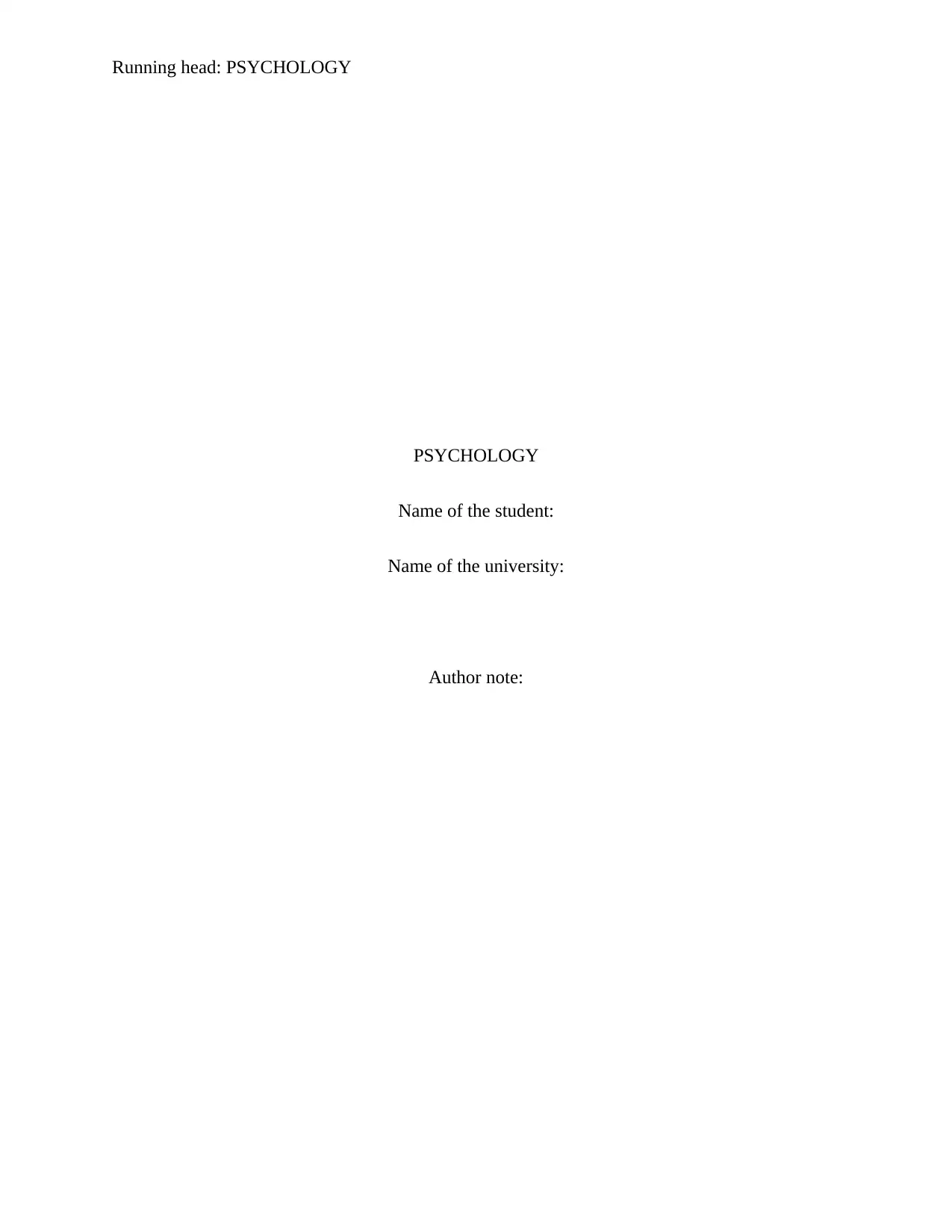
Running head: PSYCHOLOGY
PSYCHOLOGY
Name of the student:
Name of the university:
Author note:
PSYCHOLOGY
Name of the student:
Name of the university:
Author note:
Secure Best Marks with AI Grader
Need help grading? Try our AI Grader for instant feedback on your assignments.
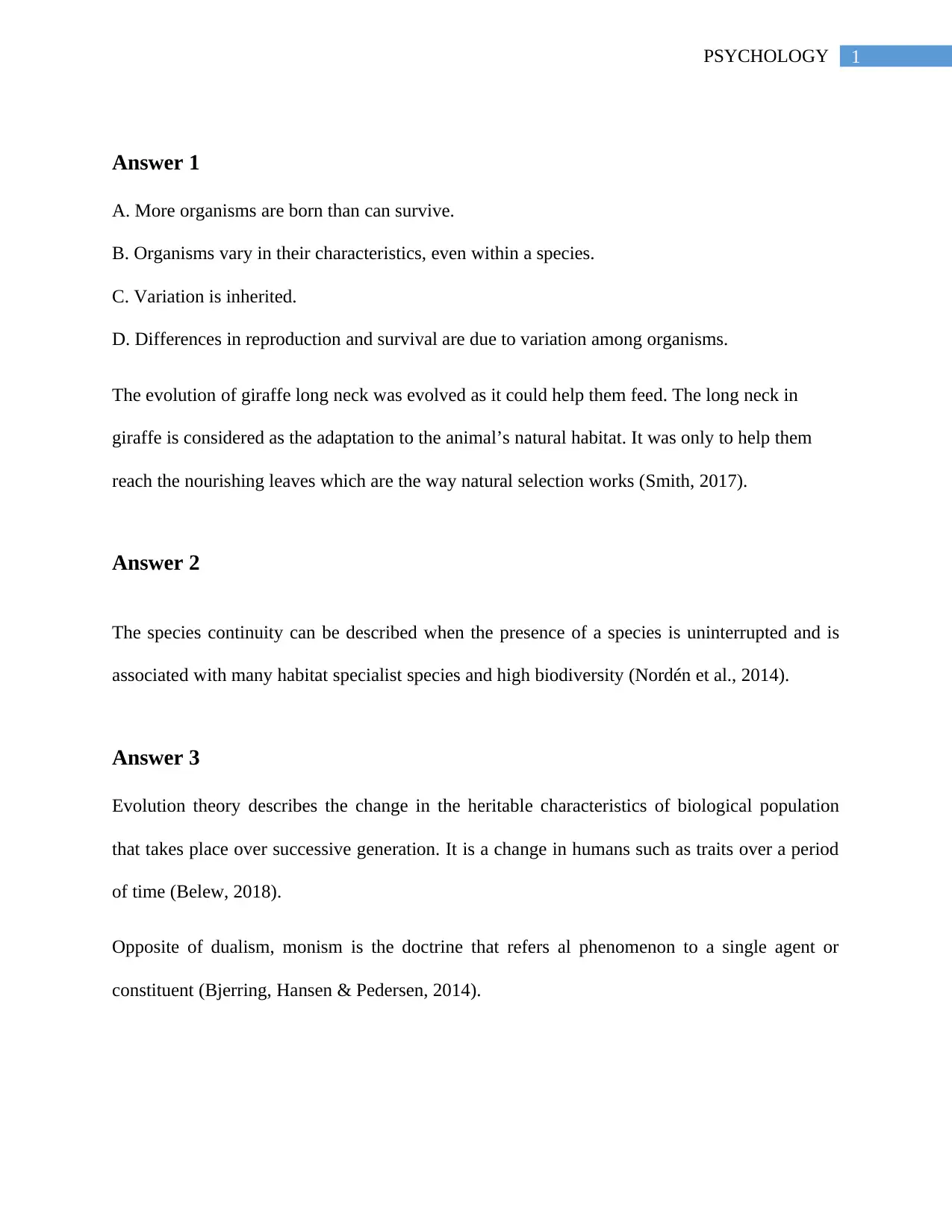
1PSYCHOLOGY
Answer 1
A. More organisms are born than can survive.
B. Organisms vary in their characteristics, even within a species.
C. Variation is inherited.
D. Differences in reproduction and survival are due to variation among organisms.
The evolution of giraffe long neck was evolved as it could help them feed. The long neck in
giraffe is considered as the adaptation to the animal’s natural habitat. It was only to help them
reach the nourishing leaves which are the way natural selection works (Smith, 2017).
Answer 2
The species continuity can be described when the presence of a species is uninterrupted and is
associated with many habitat specialist species and high biodiversity (Nordén et al., 2014).
Answer 3
Evolution theory describes the change in the heritable characteristics of biological population
that takes place over successive generation. It is a change in humans such as traits over a period
of time (Belew, 2018).
Opposite of dualism, monism is the doctrine that refers al phenomenon to a single agent or
constituent (Bjerring, Hansen & Pedersen, 2014).
Answer 1
A. More organisms are born than can survive.
B. Organisms vary in their characteristics, even within a species.
C. Variation is inherited.
D. Differences in reproduction and survival are due to variation among organisms.
The evolution of giraffe long neck was evolved as it could help them feed. The long neck in
giraffe is considered as the adaptation to the animal’s natural habitat. It was only to help them
reach the nourishing leaves which are the way natural selection works (Smith, 2017).
Answer 2
The species continuity can be described when the presence of a species is uninterrupted and is
associated with many habitat specialist species and high biodiversity (Nordén et al., 2014).
Answer 3
Evolution theory describes the change in the heritable characteristics of biological population
that takes place over successive generation. It is a change in humans such as traits over a period
of time (Belew, 2018).
Opposite of dualism, monism is the doctrine that refers al phenomenon to a single agent or
constituent (Bjerring, Hansen & Pedersen, 2014).
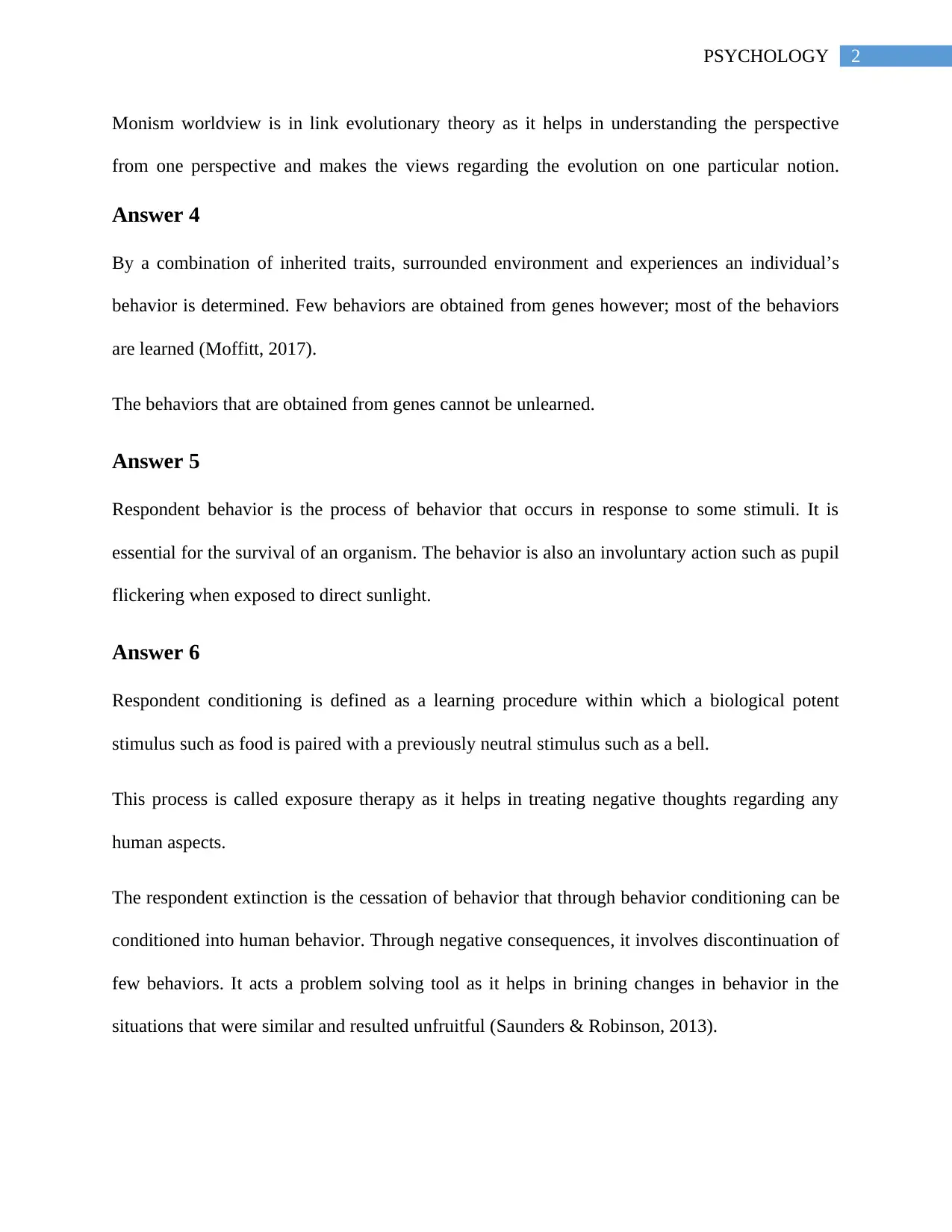
2PSYCHOLOGY
Monism worldview is in link evolutionary theory as it helps in understanding the perspective
from one perspective and makes the views regarding the evolution on one particular notion.
Answer 4
By a combination of inherited traits, surrounded environment and experiences an individual’s
behavior is determined. Few behaviors are obtained from genes however; most of the behaviors
are learned (Moffitt, 2017).
The behaviors that are obtained from genes cannot be unlearned.
Answer 5
Respondent behavior is the process of behavior that occurs in response to some stimuli. It is
essential for the survival of an organism. The behavior is also an involuntary action such as pupil
flickering when exposed to direct sunlight.
Answer 6
Respondent conditioning is defined as a learning procedure within which a biological potent
stimulus such as food is paired with a previously neutral stimulus such as a bell.
This process is called exposure therapy as it helps in treating negative thoughts regarding any
human aspects.
The respondent extinction is the cessation of behavior that through behavior conditioning can be
conditioned into human behavior. Through negative consequences, it involves discontinuation of
few behaviors. It acts a problem solving tool as it helps in brining changes in behavior in the
situations that were similar and resulted unfruitful (Saunders & Robinson, 2013).
Monism worldview is in link evolutionary theory as it helps in understanding the perspective
from one perspective and makes the views regarding the evolution on one particular notion.
Answer 4
By a combination of inherited traits, surrounded environment and experiences an individual’s
behavior is determined. Few behaviors are obtained from genes however; most of the behaviors
are learned (Moffitt, 2017).
The behaviors that are obtained from genes cannot be unlearned.
Answer 5
Respondent behavior is the process of behavior that occurs in response to some stimuli. It is
essential for the survival of an organism. The behavior is also an involuntary action such as pupil
flickering when exposed to direct sunlight.
Answer 6
Respondent conditioning is defined as a learning procedure within which a biological potent
stimulus such as food is paired with a previously neutral stimulus such as a bell.
This process is called exposure therapy as it helps in treating negative thoughts regarding any
human aspects.
The respondent extinction is the cessation of behavior that through behavior conditioning can be
conditioned into human behavior. Through negative consequences, it involves discontinuation of
few behaviors. It acts a problem solving tool as it helps in brining changes in behavior in the
situations that were similar and resulted unfruitful (Saunders & Robinson, 2013).
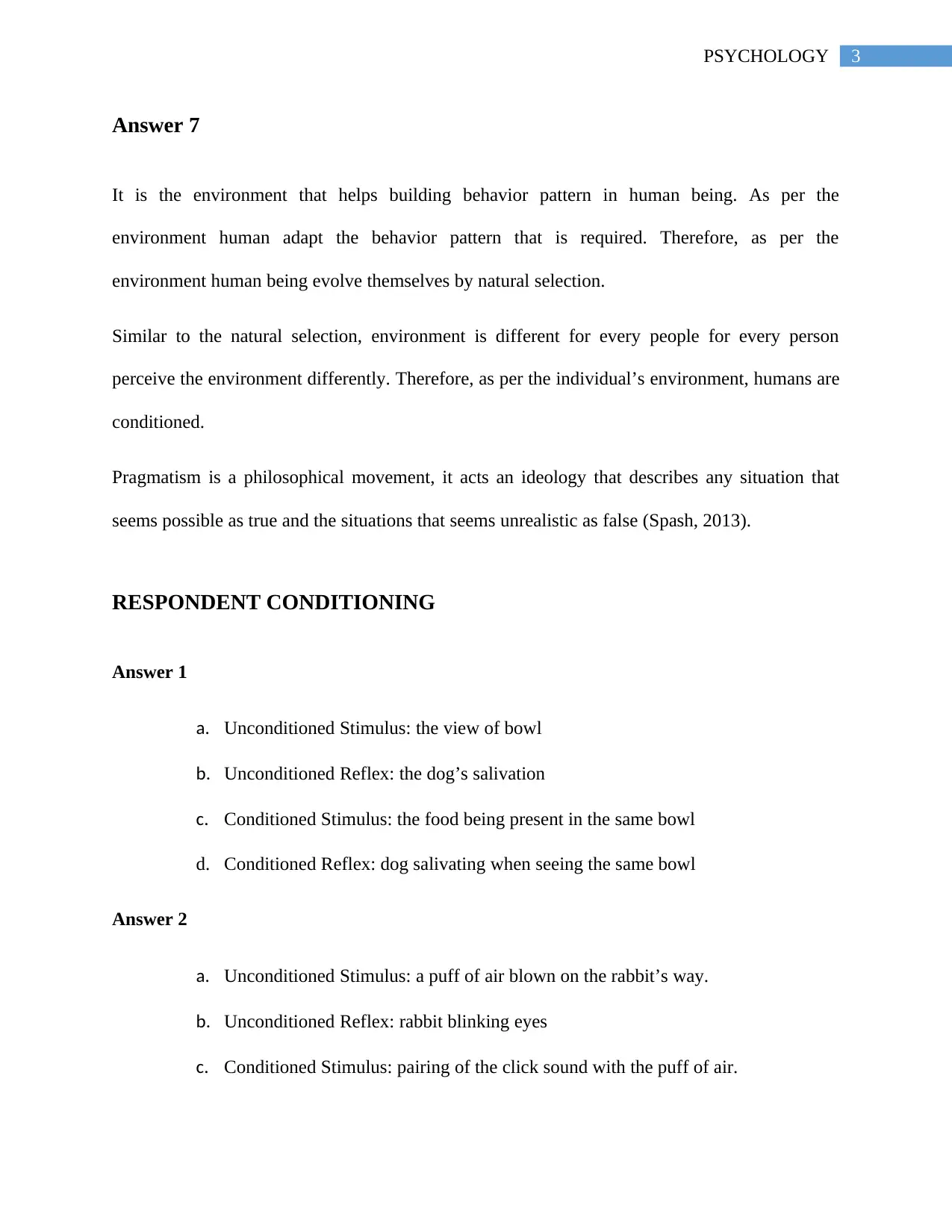
3PSYCHOLOGY
Answer 7
It is the environment that helps building behavior pattern in human being. As per the
environment human adapt the behavior pattern that is required. Therefore, as per the
environment human being evolve themselves by natural selection.
Similar to the natural selection, environment is different for every people for every person
perceive the environment differently. Therefore, as per the individual’s environment, humans are
conditioned.
Pragmatism is a philosophical movement, it acts an ideology that describes any situation that
seems possible as true and the situations that seems unrealistic as false (Spash, 2013).
RESPONDENT CONDITIONING
Answer 1
a. Unconditioned Stimulus: the view of bowl
b. Unconditioned Reflex: the dog’s salivation
c. Conditioned Stimulus: the food being present in the same bowl
d. Conditioned Reflex: dog salivating when seeing the same bowl
Answer 2
a. Unconditioned Stimulus: a puff of air blown on the rabbit’s way.
b. Unconditioned Reflex: rabbit blinking eyes
c. Conditioned Stimulus: pairing of the click sound with the puff of air.
Answer 7
It is the environment that helps building behavior pattern in human being. As per the
environment human adapt the behavior pattern that is required. Therefore, as per the
environment human being evolve themselves by natural selection.
Similar to the natural selection, environment is different for every people for every person
perceive the environment differently. Therefore, as per the individual’s environment, humans are
conditioned.
Pragmatism is a philosophical movement, it acts an ideology that describes any situation that
seems possible as true and the situations that seems unrealistic as false (Spash, 2013).
RESPONDENT CONDITIONING
Answer 1
a. Unconditioned Stimulus: the view of bowl
b. Unconditioned Reflex: the dog’s salivation
c. Conditioned Stimulus: the food being present in the same bowl
d. Conditioned Reflex: dog salivating when seeing the same bowl
Answer 2
a. Unconditioned Stimulus: a puff of air blown on the rabbit’s way.
b. Unconditioned Reflex: rabbit blinking eyes
c. Conditioned Stimulus: pairing of the click sound with the puff of air.
Secure Best Marks with AI Grader
Need help grading? Try our AI Grader for instant feedback on your assignments.
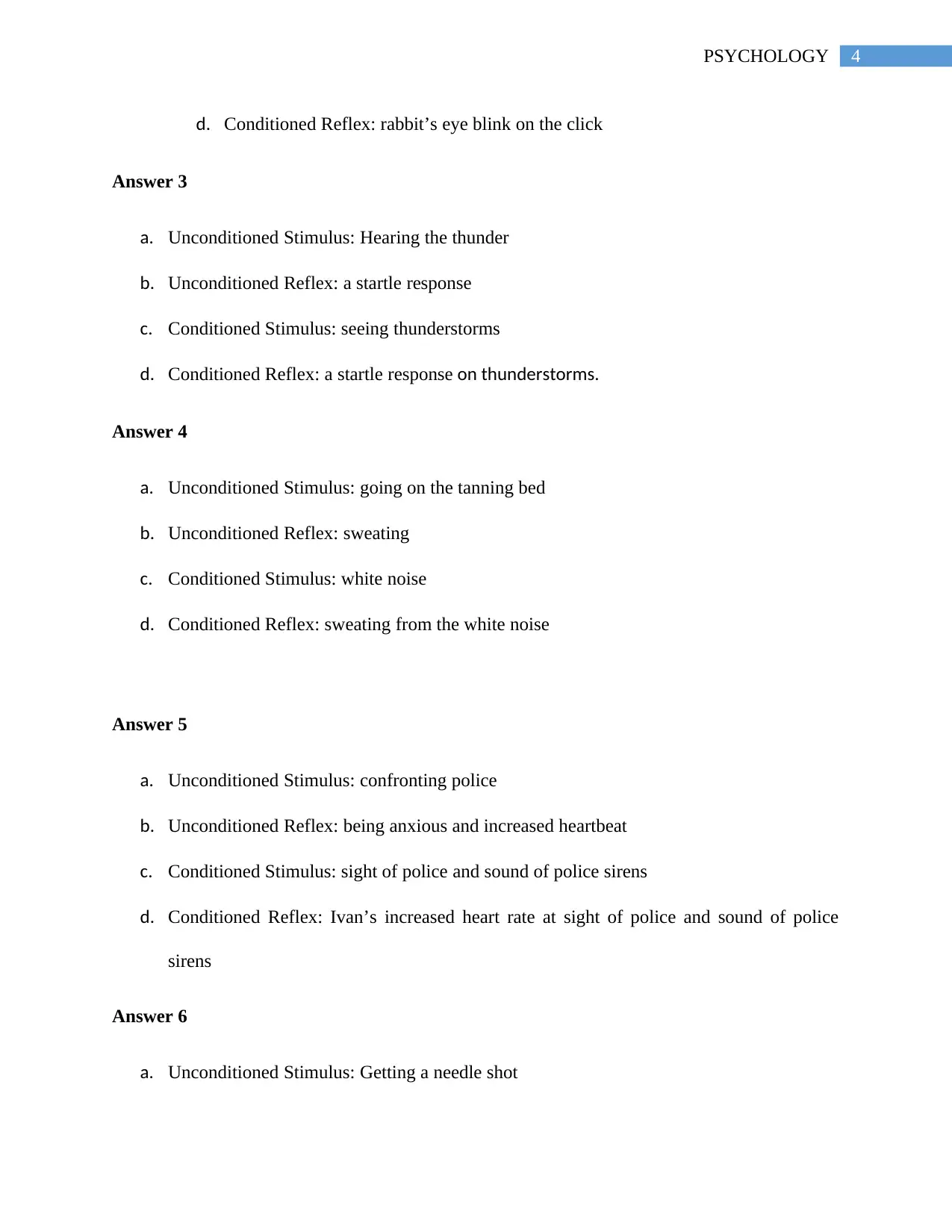
4PSYCHOLOGY
d. Conditioned Reflex: rabbit’s eye blink on the click
Answer 3
a. Unconditioned Stimulus: Hearing the thunder
b. Unconditioned Reflex: a startle response
c. Conditioned Stimulus: seeing thunderstorms
d. Conditioned Reflex: a startle response on thunderstorms.
Answer 4
a. Unconditioned Stimulus: going on the tanning bed
b. Unconditioned Reflex: sweating
c. Conditioned Stimulus: white noise
d. Conditioned Reflex: sweating from the white noise
Answer 5
a. Unconditioned Stimulus: confronting police
b. Unconditioned Reflex: being anxious and increased heartbeat
c. Conditioned Stimulus: sight of police and sound of police sirens
d. Conditioned Reflex: Ivan’s increased heart rate at sight of police and sound of police
sirens
Answer 6
a. Unconditioned Stimulus: Getting a needle shot
d. Conditioned Reflex: rabbit’s eye blink on the click
Answer 3
a. Unconditioned Stimulus: Hearing the thunder
b. Unconditioned Reflex: a startle response
c. Conditioned Stimulus: seeing thunderstorms
d. Conditioned Reflex: a startle response on thunderstorms.
Answer 4
a. Unconditioned Stimulus: going on the tanning bed
b. Unconditioned Reflex: sweating
c. Conditioned Stimulus: white noise
d. Conditioned Reflex: sweating from the white noise
Answer 5
a. Unconditioned Stimulus: confronting police
b. Unconditioned Reflex: being anxious and increased heartbeat
c. Conditioned Stimulus: sight of police and sound of police sirens
d. Conditioned Reflex: Ivan’s increased heart rate at sight of police and sound of police
sirens
Answer 6
a. Unconditioned Stimulus: Getting a needle shot
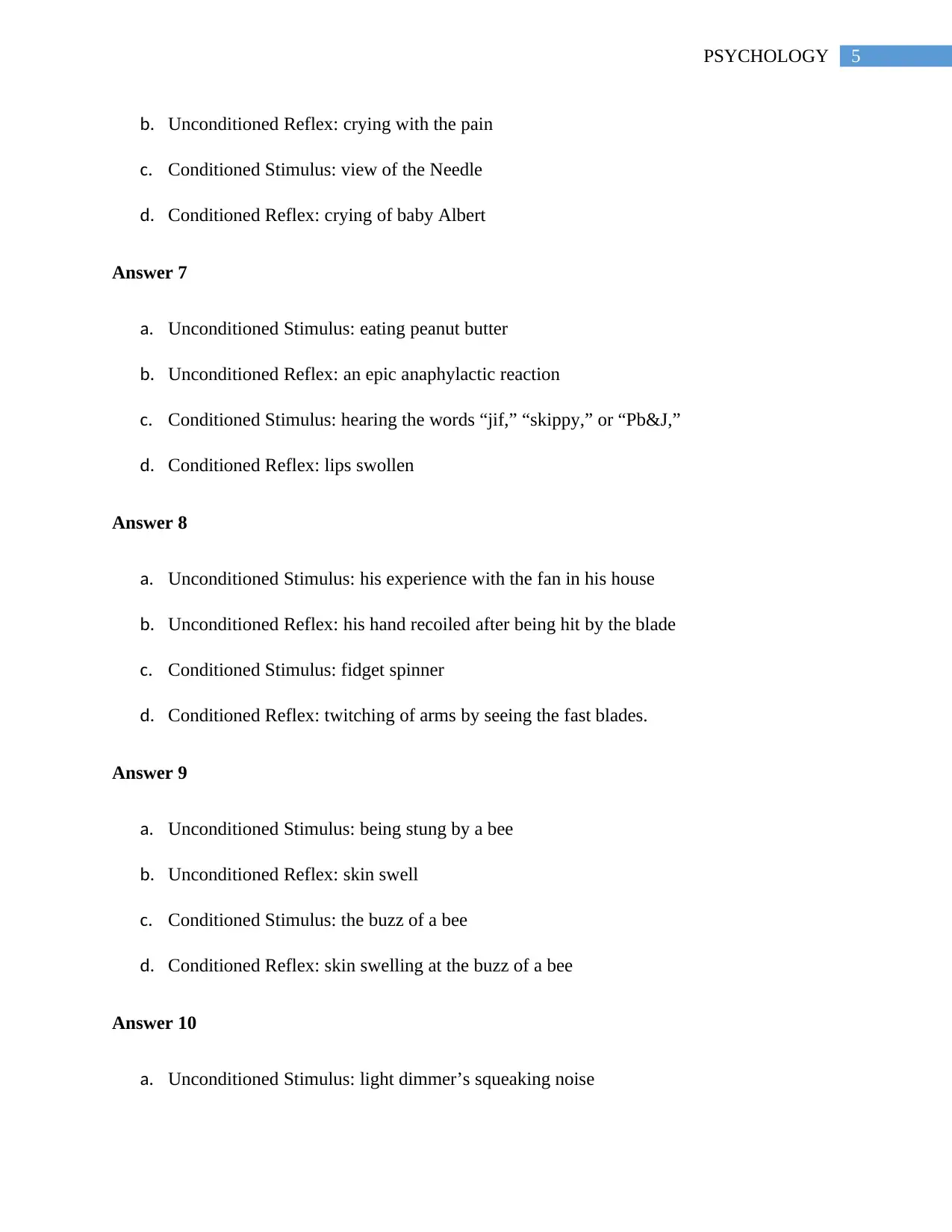
5PSYCHOLOGY
b. Unconditioned Reflex: crying with the pain
c. Conditioned Stimulus: view of the Needle
d. Conditioned Reflex: crying of baby Albert
Answer 7
a. Unconditioned Stimulus: eating peanut butter
b. Unconditioned Reflex: an epic anaphylactic reaction
c. Conditioned Stimulus: hearing the words “jif,” “skippy,” or “Pb&J,”
d. Conditioned Reflex: lips swollen
Answer 8
a. Unconditioned Stimulus: his experience with the fan in his house
b. Unconditioned Reflex: his hand recoiled after being hit by the blade
c. Conditioned Stimulus: fidget spinner
d. Conditioned Reflex: twitching of arms by seeing the fast blades.
Answer 9
a. Unconditioned Stimulus: being stung by a bee
b. Unconditioned Reflex: skin swell
c. Conditioned Stimulus: the buzz of a bee
d. Conditioned Reflex: skin swelling at the buzz of a bee
Answer 10
a. Unconditioned Stimulus: light dimmer’s squeaking noise
b. Unconditioned Reflex: crying with the pain
c. Conditioned Stimulus: view of the Needle
d. Conditioned Reflex: crying of baby Albert
Answer 7
a. Unconditioned Stimulus: eating peanut butter
b. Unconditioned Reflex: an epic anaphylactic reaction
c. Conditioned Stimulus: hearing the words “jif,” “skippy,” or “Pb&J,”
d. Conditioned Reflex: lips swollen
Answer 8
a. Unconditioned Stimulus: his experience with the fan in his house
b. Unconditioned Reflex: his hand recoiled after being hit by the blade
c. Conditioned Stimulus: fidget spinner
d. Conditioned Reflex: twitching of arms by seeing the fast blades.
Answer 9
a. Unconditioned Stimulus: being stung by a bee
b. Unconditioned Reflex: skin swell
c. Conditioned Stimulus: the buzz of a bee
d. Conditioned Reflex: skin swelling at the buzz of a bee
Answer 10
a. Unconditioned Stimulus: light dimmer’s squeaking noise
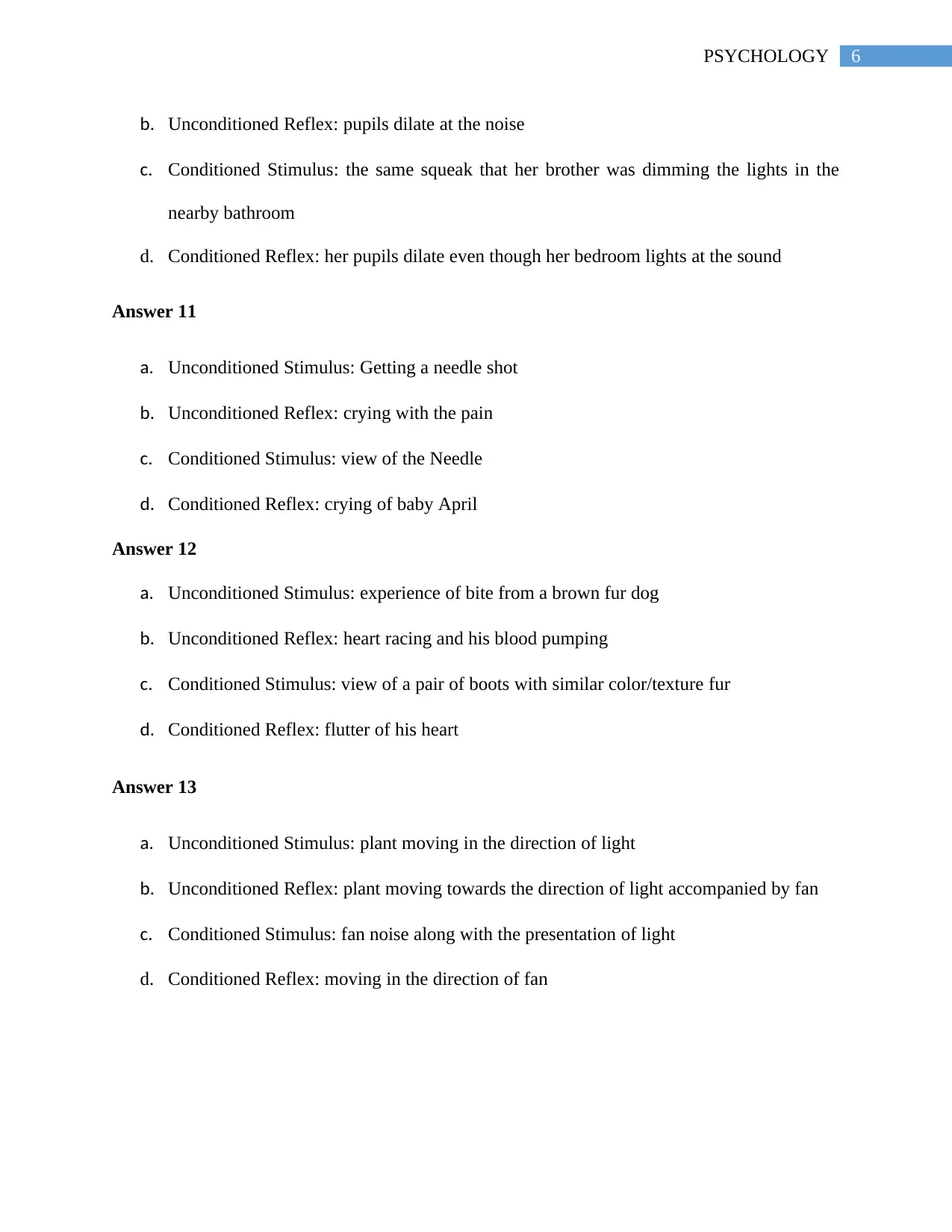
6PSYCHOLOGY
b. Unconditioned Reflex: pupils dilate at the noise
c. Conditioned Stimulus: the same squeak that her brother was dimming the lights in the
nearby bathroom
d. Conditioned Reflex: her pupils dilate even though her bedroom lights at the sound
Answer 11
a. Unconditioned Stimulus: Getting a needle shot
b. Unconditioned Reflex: crying with the pain
c. Conditioned Stimulus: view of the Needle
d. Conditioned Reflex: crying of baby April
Answer 12
a. Unconditioned Stimulus: experience of bite from a brown fur dog
b. Unconditioned Reflex: heart racing and his blood pumping
c. Conditioned Stimulus: view of a pair of boots with similar color/texture fur
d. Conditioned Reflex: flutter of his heart
Answer 13
a. Unconditioned Stimulus: plant moving in the direction of light
b. Unconditioned Reflex: plant moving towards the direction of light accompanied by fan
c. Conditioned Stimulus: fan noise along with the presentation of light
d. Conditioned Reflex: moving in the direction of fan
b. Unconditioned Reflex: pupils dilate at the noise
c. Conditioned Stimulus: the same squeak that her brother was dimming the lights in the
nearby bathroom
d. Conditioned Reflex: her pupils dilate even though her bedroom lights at the sound
Answer 11
a. Unconditioned Stimulus: Getting a needle shot
b. Unconditioned Reflex: crying with the pain
c. Conditioned Stimulus: view of the Needle
d. Conditioned Reflex: crying of baby April
Answer 12
a. Unconditioned Stimulus: experience of bite from a brown fur dog
b. Unconditioned Reflex: heart racing and his blood pumping
c. Conditioned Stimulus: view of a pair of boots with similar color/texture fur
d. Conditioned Reflex: flutter of his heart
Answer 13
a. Unconditioned Stimulus: plant moving in the direction of light
b. Unconditioned Reflex: plant moving towards the direction of light accompanied by fan
c. Conditioned Stimulus: fan noise along with the presentation of light
d. Conditioned Reflex: moving in the direction of fan
Paraphrase This Document
Need a fresh take? Get an instant paraphrase of this document with our AI Paraphraser
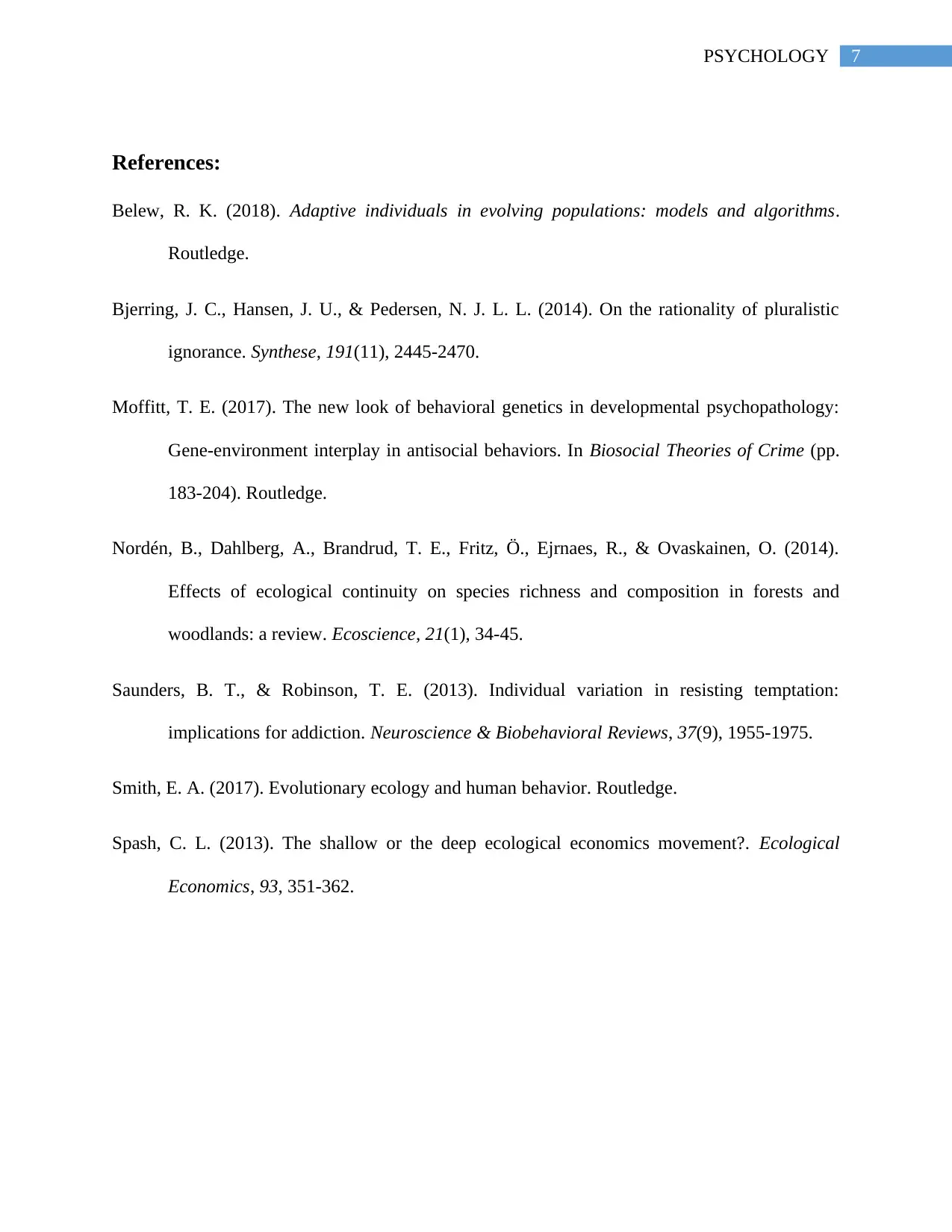
7PSYCHOLOGY
References:
Belew, R. K. (2018). Adaptive individuals in evolving populations: models and algorithms.
Routledge.
Bjerring, J. C., Hansen, J. U., & Pedersen, N. J. L. L. (2014). On the rationality of pluralistic
ignorance. Synthese, 191(11), 2445-2470.
Moffitt, T. E. (2017). The new look of behavioral genetics in developmental psychopathology:
Gene-environment interplay in antisocial behaviors. In Biosocial Theories of Crime (pp.
183-204). Routledge.
Nordén, B., Dahlberg, A., Brandrud, T. E., Fritz, Ö., Ejrnaes, R., & Ovaskainen, O. (2014).
Effects of ecological continuity on species richness and composition in forests and
woodlands: a review. Ecoscience, 21(1), 34-45.
Saunders, B. T., & Robinson, T. E. (2013). Individual variation in resisting temptation:
implications for addiction. Neuroscience & Biobehavioral Reviews, 37(9), 1955-1975.
Smith, E. A. (2017). Evolutionary ecology and human behavior. Routledge.
Spash, C. L. (2013). The shallow or the deep ecological economics movement?. Ecological
Economics, 93, 351-362.
References:
Belew, R. K. (2018). Adaptive individuals in evolving populations: models and algorithms.
Routledge.
Bjerring, J. C., Hansen, J. U., & Pedersen, N. J. L. L. (2014). On the rationality of pluralistic
ignorance. Synthese, 191(11), 2445-2470.
Moffitt, T. E. (2017). The new look of behavioral genetics in developmental psychopathology:
Gene-environment interplay in antisocial behaviors. In Biosocial Theories of Crime (pp.
183-204). Routledge.
Nordén, B., Dahlberg, A., Brandrud, T. E., Fritz, Ö., Ejrnaes, R., & Ovaskainen, O. (2014).
Effects of ecological continuity on species richness and composition in forests and
woodlands: a review. Ecoscience, 21(1), 34-45.
Saunders, B. T., & Robinson, T. E. (2013). Individual variation in resisting temptation:
implications for addiction. Neuroscience & Biobehavioral Reviews, 37(9), 1955-1975.
Smith, E. A. (2017). Evolutionary ecology and human behavior. Routledge.
Spash, C. L. (2013). The shallow or the deep ecological economics movement?. Ecological
Economics, 93, 351-362.
1 out of 8
Related Documents
Your All-in-One AI-Powered Toolkit for Academic Success.
+13062052269
info@desklib.com
Available 24*7 on WhatsApp / Email
![[object Object]](/_next/static/media/star-bottom.7253800d.svg)
Unlock your academic potential
© 2024 | Zucol Services PVT LTD | All rights reserved.





